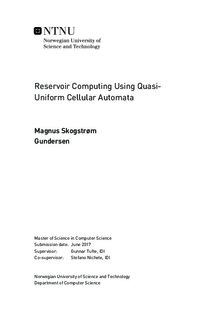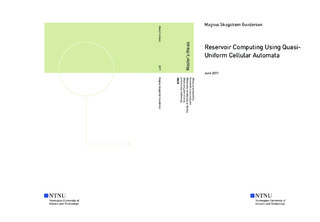| dc.description.abstract | Unconventional computing offers many advantages over traditional computing systems; vast parallelism, scalability and robustness among others. A Cellular Automaton (CA) is a biologically inspired computational substrate that has these properties. The most simple CA is an elementary CA, which consists of a one dimensional vector of binary cells.
The cells are only aware of their own value, called a state, as well as the state of neighbor to the left and right. The 1D vector can then be iterated for a number of times, where the next state of a cell is decided by the cells own look-up table, called rule. The rule is a function of the states of the two neighbors and itself. This simple substrate can be utilized for computation.
Reservoir Computing (RC) is a paradigm within Artificial Intelligence (AI) that is used for analysis of temporal data. An RC-system consists of two parts; a dynamical system, called a reservoir, and a classifier, called a readout-layer. Any dynamical system can be utilized as a reservoir, as long as it has some distinct properties that makes it applicable for computation.
CA has these properties, and thus can be used as a reservoir. This combination is called ReCA: Reservoir Computing using Cellular Automata.
In this thesis, the usage of quasi-uniform CA as the reservoir is explored. In a quasi-uniform CA, the 1D vector is split into sub-vectors, where the cells in each sub-vector has the same rule. The sub-vectors are concatenated to make up the full CA vector, such that the last cell in one sub-vector is the neighbor of the first cell in the next sub-vector. This enables information to flow between the sub-vectors. In this thesis, the rules that are applied to each of the sub-vectors are evolved by using an evolutionary process called a Genetic Algorithm.
Many real world problems have sequential data in some way, and RC can be used for processing such data. However, many sequential problems have unknown or varying sequence lengths, which can be a challenge for some RC systems. In this thesis, a framework for applying ReCA systems to sequence-to-sequence learning is proposed for the first time.
The quasi-uniform CA proved very successful on simple problems, where the evolutionary process was allowed to run for a long time. However, when dealing with more difficult problems, the quasi-uniform CA was only able to show a slightly better performance than uniform CA.
The sequence-to-sequence framework worked as intended, but it was not able to demonstrate state-of-the-art performance on well known benchmarks. However, as a proof-of-concept, it did produce promising results, and is a plausible approach for further research on sequence-to-sequence learning. | |

